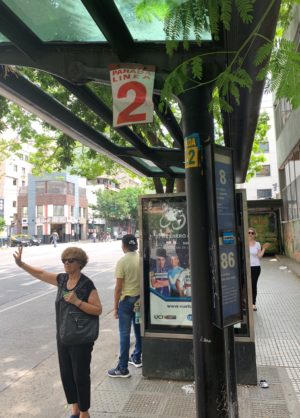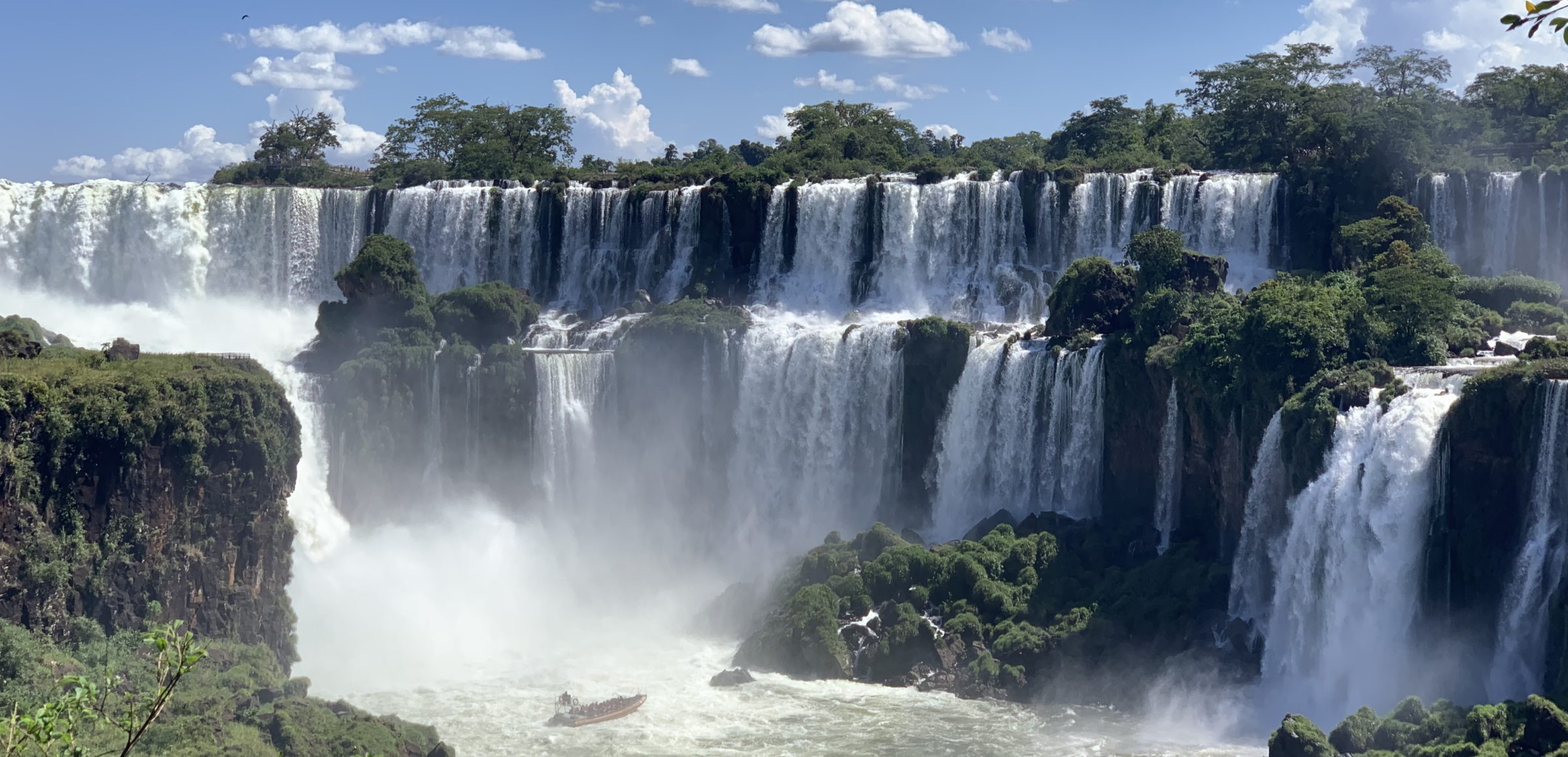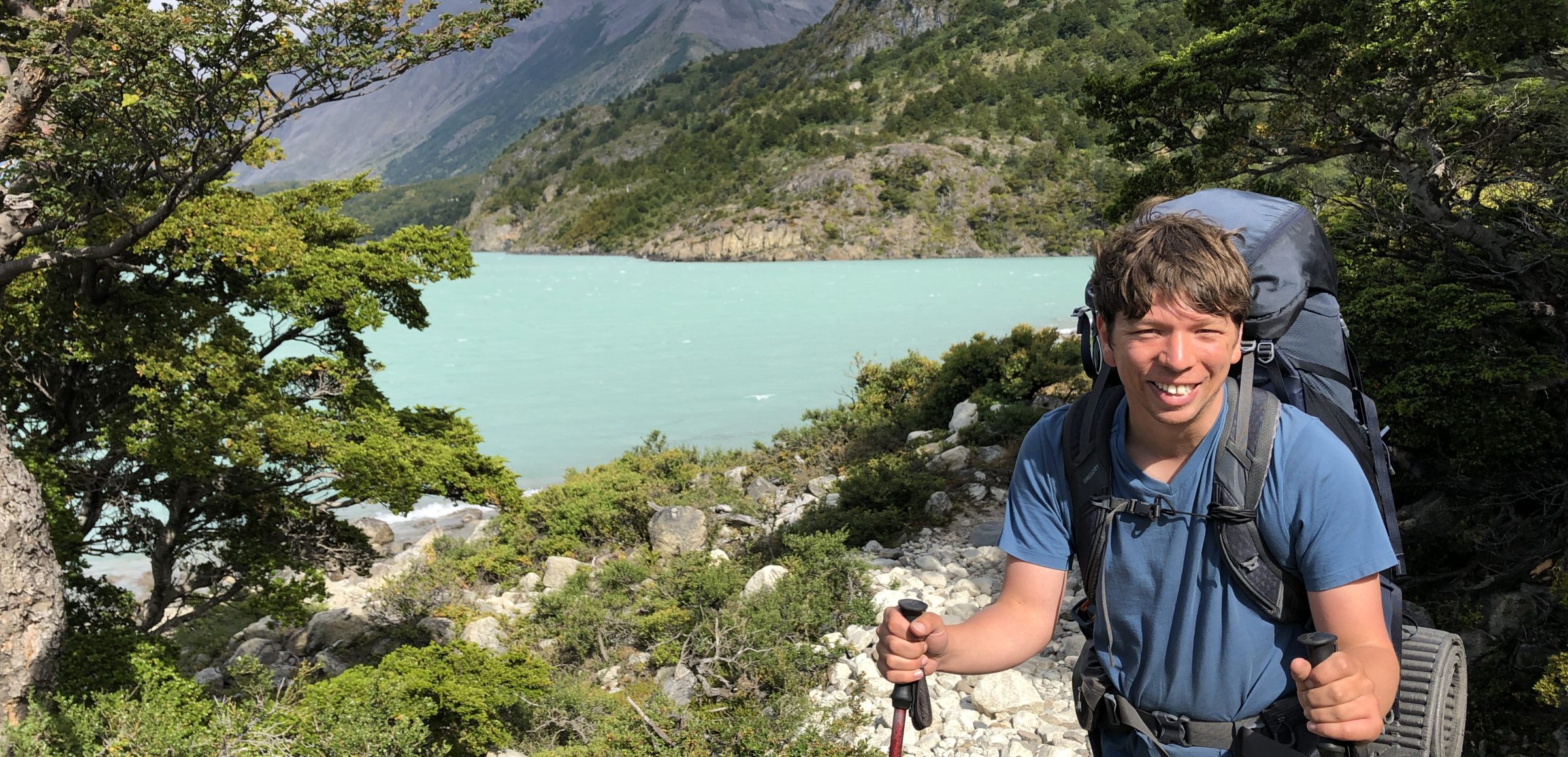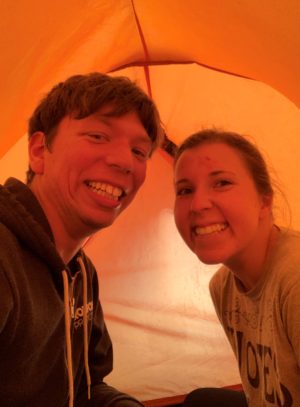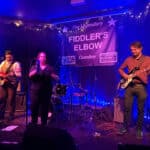We reached a new country! Perhaps not entirely legally, but… we’ll get to that. Welcome to Montevideo, the capital of Uruguay.

I had built up a whole picture of Montevideo in my head inspired by a couple of offhand comments from Francisco about Uruguay being rich and prosperous. This had magnified in my mind until the city turned into Argentina’s Monaco: a super-wealthy enclave where wealthy people keep their yachts. This is not accurate, which is probably a good thing for the people who live here and definitely for our wallets. It’s perfectly nice, and a bit on the pricey side, but it’s not glitzy.
We arrived to Montevideo from Buenos Aires by ferry on Sunday. Well, actually we arrived at a place called Colonia and then hopped on a coach for several hours since this is substantially cheaper than taking the ferry the whole way. By the time we had settled into our Airbnb and strolled down La Rambla into the historic old town we discovered that almost everything here on a Sunday is very, very shut. This isn’t a complaint – I kinda admire it – but it’s a clear contrast with Buenos Aires and gives some of idea of Montevideo’s quieter character.
Walking down La Rambla is absolutely wonderful, by the way. Wikipedia claims it’s the longest continuous pavement in the world, albeit hedged with a ‘citation needed’ flag. Regardless, it’s 22km along the coast, smells of the sea and is filled with people sitting and drinking mate from thermos flasks. We tried this back in Ushuaia and it wasn’t our cup of mate, but it’s nice to have a shared drink that the country enjoys together. As it happens, I woke up this morning to discover that a new mate emoji is on the way so organising your social drinking on La Rambla is about to get even easier.

After having dinner at one of the very few open restaurants in the old city we were surprised to find a negative charge on the receipt labelled “DESCUENTO Ley 17934” (DISCOUNT Law 17934). Some puzzled googling revealed that this was an automatic VAT refund paid to holders of foreign cards. I know that VAT can theoretically be claimed back by visitors in most countries but have never met anyone who actually bothers to do it, so this was a welcome surprise. It does feels slightly weird to be paying 18% less than the advertised price which a local person would pay, and presumably the system is open to some abuse. But the discount is automatically applied, so we’ll take it!
Talking of laws: after we went through immigration in Buenos Aires and got our exit stamp from Argentina, the woman at the immigration desk gestured vaguely for us to “go to gate 8”. This perplexed us since there is no gate 8 at the port, and only later did I realise that she was talking about another immigration desk for us to get our entry stamp for Uruguay. So, on Monday morning – disturbed at the idea of being held or fined when we tried to leave again – we trudged on down to the government migration office to sort it out. After Randi explained our problem in suitably contrite Spanish the woman at the desk confirmed that we were “not in the system” but was perfectly happy to blame Argentina for the mistake and claimed we wouldn’t have a problem leaving. As I finish writing this on the ferry back to Buenos Aires I am happy to confirm that she was correct.

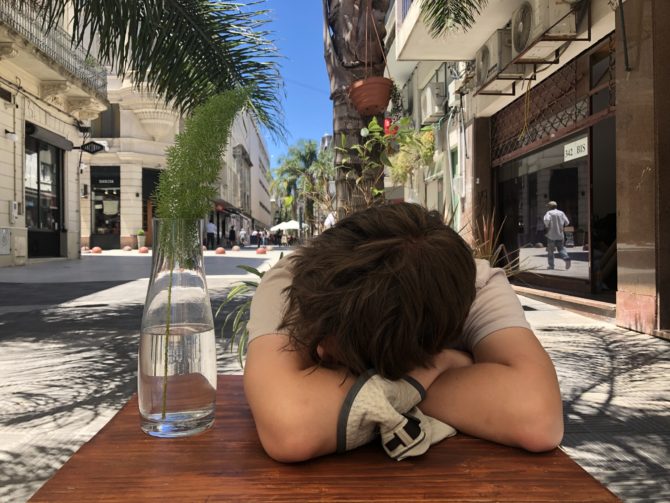
All of these laws like “give foreigners a discount” and “don’t be too harsh on tourists without entry stamps” have to come from somewhere, and specifically from the General Assembly of Uruguay. After failing to tour the Congress in Buenos Aires we made a special effort to visit the legislature here, and pestered our guide with questions about the legislative process and the electoral system when she was clearly more practised talking about the paintings. (The paintings are fine. One of them shows the British acting as mediators between Uruguay, Brazil and Argentina – we’d never get that gig today.) We did establish that when the House of Representatives deadlocks with the Senate they convene a general assembly together and vote as one body, which seems smart.
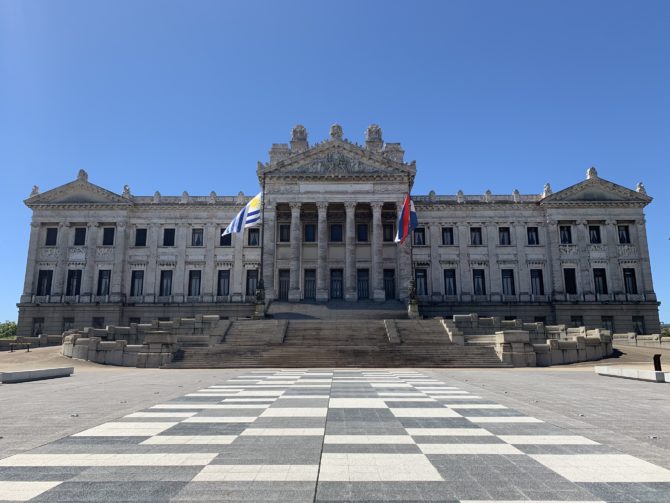

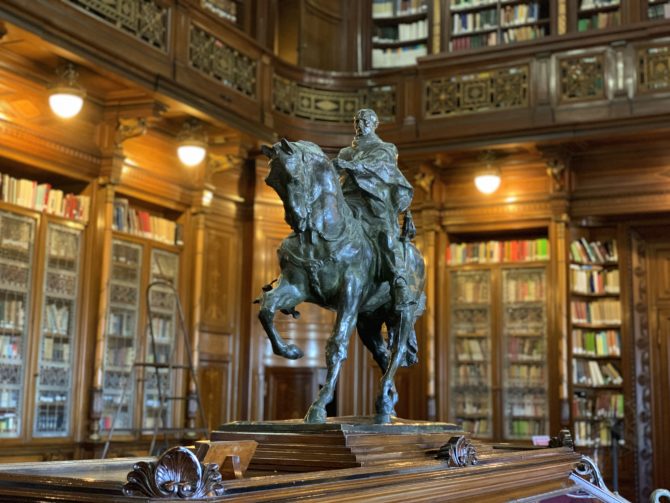
Back in Puerto Varas in Chile, one month ago, we decided that we would mark each month’s travelling anniversary with a fancier, more expensive dinner than we would normally allow ourselves. Back then we really enjoyed our food and sangria at
El Humedal but in retrospect it was nothing compared to the incredible meal we had at Restaurante Tandory in Montevideo for month two. It’s a small, atmospheric restaurant – the kind of place where the chef came over to talk to us halfway through our meal – and my chicken mole was absolutely amazing. Wherever we are in a month’s time will find it very difficult to top this.
On our last full day in Montevideo we wandered up La Rambla in the other direction to the beachy part of town before coming back in the evening for dinner, cocktails and jazz. Not glitzy, but cosy. The tone changed a bit in the last 24 hours since our Airbnb had a few challenges… Randi does a better job at enumerating the full list of issues, but suffice to say that leaving this morning (without a shower as the water was out) felt like a great escape. I’m very excited about showering again in the warm embrace of Buenos Aires before we leave tomorrow for approximately 700 hours of flying until we reach Singapore.

Asia, here we come!
Just as with Santiago, it’s much more difficult to write about visiting a big city than somewhere small. We’ve now stayed in two different neighbourhoods of Buenos Aires – first in Palermo, now in Almagro – and we still feel that we can’t quite put our finger on the city since there is so much of it to see and explore. We’ve been comparing Buenos Aires to Santiago a lot, actually – sorry, Lima, but you need a real subway to participate in this game – and Santiago actually felt more compact even though it is statistically much larger. This is probably just a quirk of urban boundaries plus our own idiosyncrasies in where we went. But the two cities certainly have a very different feel.

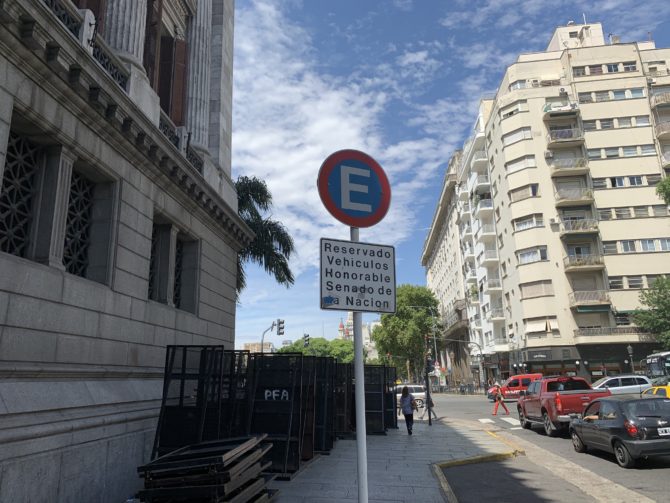
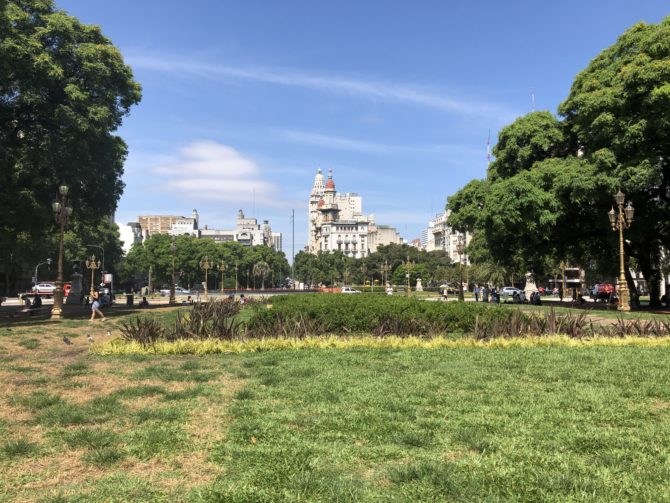
We flew into the smaller city airport rather than the big international one so it was a quick ride to our first Airbnb through the large Parque Tres de Febrero which includes a planetarium, lakes and rose gardens. (The guy on the plane next to me was just starting the ginormous paperback sequel to a fantasy novel, The Name of the Wind, which I was simultaneously finishing in svelte Kindle form. We bonded over how amazing its fantasy world is, and I was grateful that his edition was in Spanish so I wouldn’t be tempted to look across and read spoilers too easily.)
Our home was close by to the free Botanical Garden, which we enjoyed wandering through, and the ‘Ecoparque‘ (“the historic Buenos Aires Zoo… re-opened as an interactive eco-park, improving animals’ standards of living, and offering visitors a more educational and fulfilling experience”) which is home to a terrifying genetically engineered kangaroo/rabbit hybrid which we first spotted at night and thought had escaped from a lab. Further discussion with Katie suggests that they are actually patagonian mara, a “relatively large” rodent.

Us being us we obviously took a walking tour which meandered from Congress to the Casa Rosada (Pink House) where the President works. I’m sure this is a minority opinion but I am always more interested in seeing the inside of legislatures rather than executive buildings. Passing laws is very distinctive looking; presidenting just requires desks, sofas and maybe a podium. Unfortunately we tried twice to get a tour inside Congress and failed both times as they kept pushing back the date for the building to re-open and laughed at our earnestness. So, no Argentinian lawmaking action for this blog I’m afraid.
We also visited the famous Recoleta Cemetery – some very elaborate graves but overall not quite as beautiful as the grassier cemetery in Punta Arenas – as well as the Fine Arts Museum nearby, which had a reasonably high ratio of ‘art I enjoy for a bit’ to ‘art I can’t really bring myself to like’. They also had a special Turner exhibition which was almost in the dark to prevent you from damaging the paintings by being able to see them.
And yes, of course we went to see tango. We chose a relatively inexpensive tango show and were pleasantly surprised to discover that they didn’t gouge you on drinks to make up for it. Randi had to double-check that the wine prices listed were actually for bottles and not glasses. Suitably reassured, we enjoyed the performance although at times it was a bit… odd. Mostly it purported to tell a down-on-their-luck tale of American immigrants, but then abruptly cut to Eva Perón standing on the balcony of the Casa Rosada singing Don’t Cry For Me Argentina. As the music swelled and the LED screen switched to a fluttering Argentinian flag, one man in the audience was so overcome with patriotic fervour that he stood up and started shouting “ARGENTINA!” as the crowd applauded. I thought we had drifted a little from the tango theme.
Afterwards we walked a short distance to the casino – past a nice view of the Woman’s Bridge at night – and attempted to use our 200 peso “free credit” from the tango company. We are not really casino people and this all got very confusing (imagine us both sitting at machines, randomly pressing buttons and trying to work out if we had actually spent any money yet) but we did get bags of free (and delicious) sweet popcorn out of the experience before riding the bus home after our only ‘late-night’ in Buenos Aires somewhere around 1am.
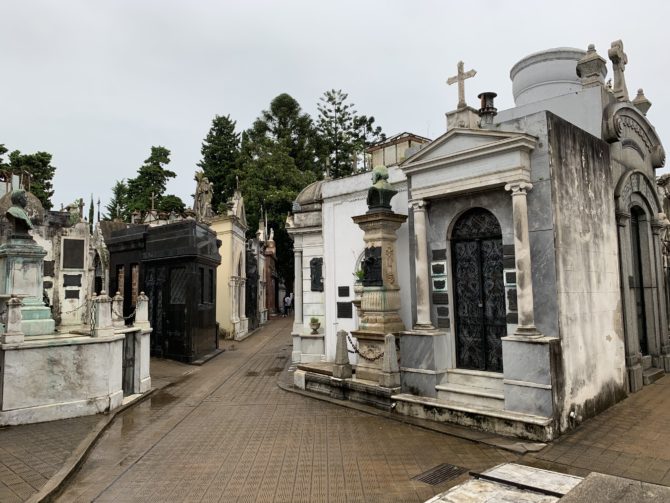

Again, as you already know, we’re not really nightlife people. So I’m going to use that story as a bridge not to talk about the bars and clubs of Buenos Aires but something much more important: the transport! As already mentioned, Buenos Aires does have a subway and it seems to be a pretty extensive and decent system. For whatever reason we didn’t end up using it a huge amount and relied more on the huge network of buses.
I can’t decide whether the buses in Buenos Aires are inspired or insane. The ‘system’ is actually a hive of independent companies doing their own thing. They have managed to get everyone onto one unified smartcard system (the SUBE card) which is great, although you still have to tell the driver where you’re going which seems to alter the fare only very slightly. The variation in fares seems small enough that a flat rate would make everyone’s lives a lot easier. The buses are very frequent – they don’t run to schedules, just “every X minutes” – and are incredibly popular, with lots of redundancy between routes.
So that’s all great, only there are a few problems. The bus stops themselves are a random assortment of shelters and lampposts, with no consistency in how route numbers are displayed between different companies. And the buses don’t seem all that keen on actually stopping at the bus stops… sometimes you have to really throw yourself in its path and hope for the best. But worst of all are the letters. You see, many routes actually have multiple variants (e.g. the 160A, 160B, 160C and so on) and these can go all over the place. There are no maps at the bus stops to show you the differences and the letters themselves are barely visible on the actual buses, so all of your effort to hail the bus in the first place may be in vain if you board and then discover that, oh no, this may be an 160 but it isn’t the 160 which goes anywhere near where you want to go.
There’s room for improvement, that’s all I’m saying.



The other thing to mention about Buenos Aires is the food, and this is definitely an area where the city wins out over Santiago: you can eat a lot more variety of great meals for less money. We’ve had drinks at the famous Café Tortoni, enjoyed chorizo sausages from one of the many parrilla, found our favourite burger joint, eaten at Mexican, Indian and Armenian restaurants and had even had one last hurrah of Peruvian food from a place intent on serving gigantic portions. Hey, even the random dude in the park selling chocolate brownies produced some of the tastiest brownies we could remember. You won’t be disappointed with the food in Buenos Aires.
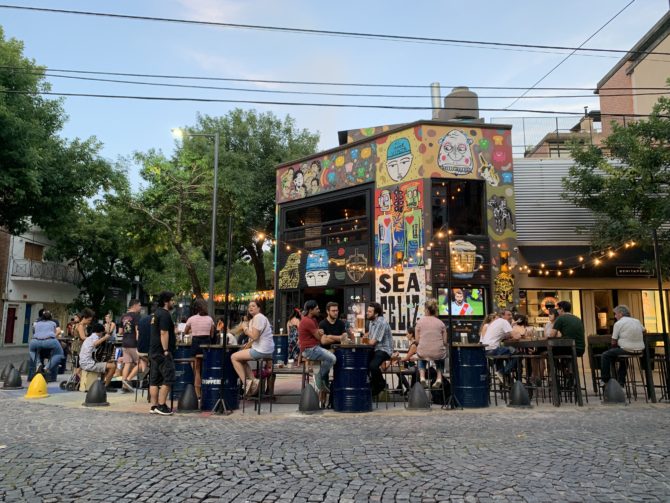

Of course, there is no reason to force any comparison between Santiago and Buenos Aires at all, other than it’s useful for us when we’re reflecting on the cities we’ve seen on our travels. I can totally see why Buenos Aires is so popular: there’s a lot here, and while at times the weather has been very hot and humid we’ve still managed to get around easily to see a lot of it. At the same time, the most common thing I’ve heard about Buenos Aires in casual conversation is that it’s a very “European city” – which, if you’re visiting from Europe, raises the question of why you would fly across the Atlantic to get here. It’s probably best combined with some uniquely South American nature – which is why I’m glad we used Buenos Aires as a base for our break to Iguazú when we did.
Tomorrow we will be leaving to spend a few days in Montevideo, the capital of Uruguay, before heading back to Buenos Aires very briefly and then wrapping up the South American leg of our trip!
Now for a little jump forward in time. After leaving Ushuaia we spent the rest of last week in Buenos Aires, but I thought I would save all of my Buenos Aires material for one post and write first about our side-quest to Puerto Iguazú and the Iguazú Falls. This was a wonderful diversion but not a place gifted with excellent WiFi – or at least we ran out of things to order in different cafés to keep testing the connection speeds – so now there is some blogging catch-up to do.
Ethical note: this post was made possible courtesy of my mother who generously provided our flights to Iguazú. All opinions about my mother are my own.
OK, so we hadn’t originally planned to visit Iguazú since it wasn’t really on our path – in fact, it’s possible we explicitly told our vaccination nurse that we weren’t coming here to get out of something or other – but we kept picking up the recommendation that it would be worth the detour. The area around the falls is shared by Brazil (Iguaçu National Park) and Argentina (Iguazú National Park) although the general consensus online is that the Argentinian side has the edge. Either way, we weren’t about to pay $160 to get Randi into Brazil (equivalent cost for a British citizen: £0) so we spent two days in Argentina’s National Park.

The park is extremely well sign-posted and organised with almost a theme-park vibe (in a good way… such as having a brightly colour-coded map) although it does get rather crowded at the most popular points. On our first day we had planned to walk the Garganta del Diablo Trail – the famous ‘Devil’s Throat’ – and the Upper Circuit, because this is what various blogs told us we could comfortably manage in a day. The blogs are wrong. All of the trails are very easy to walk and despite not arriving particularly early we still had plenty of time and energy left to walk the Lower Circuit before the park closed. Don’t believe anything you read on the internet.
The Upper Circuit was probably our favourite, but the Devil’s Throat is certainly spectacular and (whisper it) maybe more impressive than Niagara Falls. I mean, I haven’t seen Niagara in the summer and I don’t want to hurt its feelings, so let’s just agree that they are both great and you should definitely visit. We also had a magical burst of fake-rain water spray while we stood at the top which was cool and refreshing.

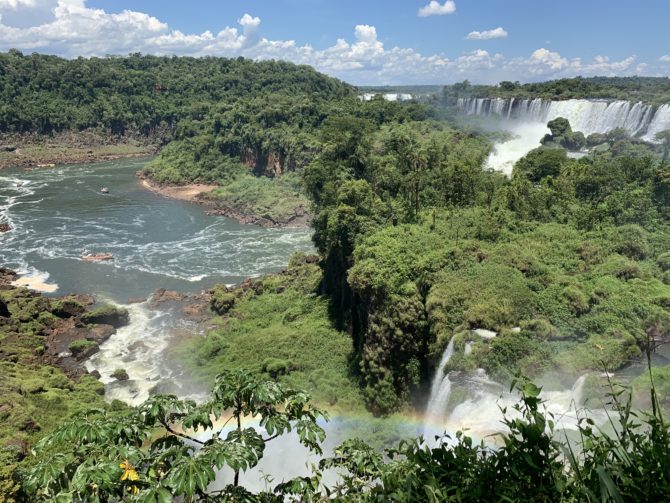

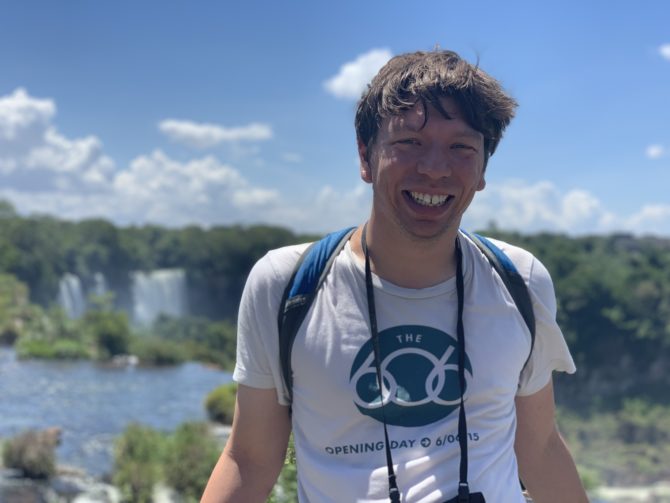

On the second day (for which you get a 50% discount to re-enter the park) we used gift money from Randi’s aunt to take the Great Adventure tour through a jungle path and then up to the falls in a boat. The highlight of the jungle was seeing a mother and baby bird cunningly disguised as the top of a tree stump – so cunning, in fact, that I almost missed it. We were less smitten with all of the giant spiders who hung above the jeep as we stopped to talk about how impressive their webs were. And Randi was not thrilled to learn that the area is home to 50 species of snake, of which only a mere 10 are venomous. I thought those were good odds.
But no one pays for this tour to marvel at the Earth’s precious and endangered species, obviously. They do it to be taken under the waterfalls at high speed and get completely drenched, which was a lot of fun.


To dry off we walked the markedly less popular Macuco Trail where we saw our first monkeys of the trip. From what I remember of Asia they will become much less of a novelty, but we enjoyed seeing them in the trees. I have more mixed feelings about the coati which run amok in some areas of the park and particularly where innocent humans are trying to eat lunch. These raccoon-like animals are cute…ish, but they do have sharp teeth and claws and when they think a sandwich might be worth a-stealing they go crazy. I even had one poking around my legs as we set off on one of the little internal trains which take you between various points in the park.

Other than the Falls the other big tourist attraction in Iguazú is the Triple Frontera between Argentina, Brazil and Paraguay. Each country is represented by an obelisk which looks out at the others across the Iguazú and Paraná rivers and it’s an interesting test of how much effort each country is willing to put into its respective side, like neighbours who share a hedge. The Argentinian area is pretty nice – busy but relaxed, with great-smelling sausages being cooked. Brazil have built a big Ferris wheel in their area but have also gone and grown a big tree which obscures half of their obelisk so I’m deducting points for that. Paraguay… didn’t seem to have anyone at their station. (Maybe they were there and I just couldn’t see them!)
One problem with this whole arrangement: my phone kept thinking it was in Brazil and jumping one hour ahead to their timezone. This feels like a whole new category of first-world problems but it wasn’t something I ever thought about, and I bet the product managers who built the ‘Set Automatically’ toggle didn’t think about it either.


One final note about Puerto Iguazú itself: the area around our Airbnb has gone completely overboard in naming streets after significant dates. It is genuinely possible to walk up 17th October, turn right onto 25th May, make a left onto the main street of 9th July before turning again onto 1st May. This is silly. Then again, the town is home to numerous buffet-type restaurants where you can load up a plate for very little money, so I won’t hold it against them too much.
Welcome to another episode of “blogging from cafés in remote places with decent WiFi”. Today’s edition is from Ushuaia on the southern tip of Argentina, where the city’s motto is “end of the world, beginning of everything” and the claim is to be the southernmost city in the world. This is apparently somewhat contested by a Chilean town further south, but the marketing ploy has clearly worked because we’re here and not there.

We have mostly laid low during our couple of days here, relaxing and reading at our comfy AirBnb and petting its resident dog Kobe (at least, I think that’s his name) whose lack of barking and jumping puts him in the highest echelon of dogs on this trip so far. The most popular thing for tourists to do here is to see the penguins on Martillo Island, but we decided to leave the penguin-watching to David Attenborough and opted for a cheaper (i.e. free, excluding the lift there and back from our AirBnb host) hike to Laguna Esmeralda instead.
Fun fact: on the drive out of Ushuaia we went through a police checkpoint where – in an excellent use of public resources – they asked our host where we were going and then sped us on our way. The hike itself was a very gentle stroll through the countryside compared to anything on Torres del Paine, although we did encounter more mud before we arrived at our picnic destination:



In town we also made ourselves at home at a local pizza/empanada/ ‘all-round good food served cheaply and cheerfully over a counter’ kinda place. I think we went there three times in total, to the extent that they had to warn us that they close on Tuesdays. I also thought it was interesting that our host had Argentina’s civil code as a book on her shelf (is that a common thing to have lying around, like a dictionary?) but unfortunately my Spanish wasn’t really good enough to go into the difference between civil and common law systems and so I just flicked through.
Oh, and one of Ushuaia’s public parks is also home to the worst wooden slats in the entire world. It made the sort of haunted house creaking noises you usually only find in a horror film and we are quite convinced that it is supposed to be closed but someone has run off with the sign.
The last thing I really do have to mention is the Falklands, not out of any particular desire to bring it up but in Ushuaia the dispute is everywhere. Along with memorials and murals (fair enough) the slogan “Las Malvinas son argentinas” is also printed on random road-signs and even on the side of public buses. I know people on the left in Britain have a bit of a hangup about the Falklands War as the jingoism it riled up was undoubtedly a major factor in Thatcher’s re-election. That said, it’s pretty hard to argue that an independent community which has been living there for over a century and near-unanimously voted to continue living that way should be taken over by Argentina (which at the time of invasion, incidentally, was run by a military junta) on the basis of geographical neatness. The slogans in Ushuaia remind me a little of all the English monarchs who claimed to be King of France even though France was quite obviously doing its own thing. 🤷♂️

We made it! Yesterday afternoon we arrived back in Puerto Natales after a successful 5 day / 4 night expedition along the famous W Trek in Torres del Paine National Park, although for us it was very much a lowercase rather than an uppercase W for reasons I will explain later. In any case there are many different ways to hike the W so, for reference, here is the version we did:

Day 1: Paine Grande – Grey (11km)
After renting our gear (tent, sleeping bags, mats, walking poles and cooking equipment) and stocking up on food in Puerto Natales the night before we got the 7am bus into the park and then waited for the catamaran to take us across Lake Pehoé to our starting point at Paine Grande. There is only one vessel and we didn’t make it onto the first ride, so after queuing for an extra hour (during which time I reached the pivotal plot twist in Donna Tartt’s The Goldfinch) it was already lunchtime before we could start our first hike.
As you can see from the map, in terms of making a nice W shape the first day’s hike is actually completely redundant since we just walked back the next day. Still, based on the distance and altitude we both expected that the first two days would be our easiest. We were totally wrong. The first day especially was the hardest. Partly this was environmental – some parts of this route are seriously windy, and there’s a fair amount of uphill and downhill sections – but mostly it was on us. Starting later in the day is definitely worse but I also wore too many layers, didn’t strap my bag up properly and had not yet settled into the walking. We were also way slower than the guide time of three and a half hours, which wasn’t a problem in itself but was worrying given the subsequent trips we had to make.
The worst part was when Randi tripped and fell forwards onto a rocky downhill path, which left a cut on her forehead but thankfully no serious damage. We’re grateful to the helpful group of French hikers behind us who stopped to offer aid and checked for concussion before moving on! Serious public service announcement though: when we rented the walking poles, the woman at Erratic Rock warned us not to use the wrist straps. We followed her advice, and Randi was able to throw off the poles when falling. If she hadn’t been able to she could easily have broken her wrist and wouldn’t have been able to shield her head. So please follow the advice and ignore the wrist straps on walking poles!



Suffice to say, we were both extremely glad to reach Refugio Grey, put up our tent, take a hot shower and cook our first dinner using the little foldout burner which looked eerily like a robotic spider from a Doctor Who episode.
We also dutifully followed the camp’s rules and left all our food tied up in a bag and dangling from a tree overnight, even though I was pretty convinced that we would wake up the next morning to find five days worth of food spread all over the campsite. Spoiler alert: we didn’t! And so after a long day we had a recuperating and relatively comfortable night’s sleep in our tent, which joyfully didn’t blow away either.
Day 2: Grey – Paine Grande (11km)
I’ve deliberately focused on the worst parts about the first day’s hike so I would have something to write about here 😉 and I do, because the journey between Grey and Paine Grande offers amazing views of Glacier Grey! As we set out in the morning I wasn’t sure if knowing the route in advance would make things easier or harder but we did much better the second time around (only half an hour slower than the guide time) with no falling over and happier spirits overall.
Some of this might have to do with the delicious breakfast of porridge and calafate jam, topped off by tea and even some milk which was donated to us by a kind (but very unhappy) Australian woman. “The Australian woman” became a bit of a talisman for us, actually, as she kept popping up at various points along the route and complaining bitterly to Randi about what a miserable time she was having. Any of our problems seemed very mild in comparison.
We arrived at Paine Grande, struggled to put up our tent (not because it was hard but because it looked wrong, which we eventually decided was the wind’s fault) and then copied everyone else by placing large rocks over the stakes just in case. After dinner we also bought more eggs to hard boil, having very much appreciated this snacking suggestion from a Canadian back in our hostel in El Calafate. Thanks for the great idea!
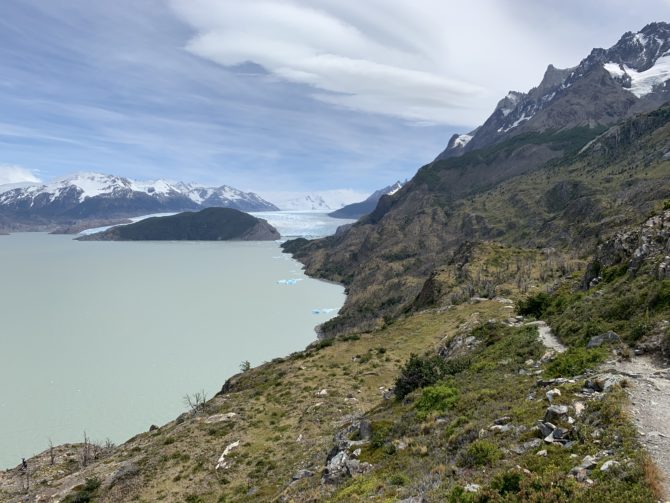

Day 3: Paine Grande – Mirador Francés – Francés (13.5km)

By the third day we were really hitting our stride and by this point onwards we either met or exceeded the guide times for the routes. After walking to Campamento Italiano (this is the basic campsite run by the park itself, which is free but does not come with any fancy frivolities like flushing toilets or showers) we left our bags and walking poles and headed uphill on the way to the Británico lookout.
This is where the ‘lowercase W’ comes in, because we didn’t get anywhere close to Británico… in fact, we almost turned back before reaching any great sights at all – which would have been a real shame – but luckily someone who was coming back down saw our tired faces and volunteered the information that Mirador Francés was only five minutes away. (In fact, he even called it ‘the main viewpoint’ which makes me feel a lot better.) And so we reached this checkpoint and declared victory, leaving Británico as a reason to come back to Torres del Paine at some point in the future.
As well as feeling that we had rescued success from the jaws of failure I also enjoyed Mirador Francés because it turned out that the couple we stopped and asked to take our photo were from Nottingham but the woman was originally from Willesden! Normally this would be the very lowest rung on this type of conversion (“Where are you from?” “London” “Where in London?” “North West London” “Where in North West London?” “Willesden”) but I was delighted to be able to go one deeper with the never-before-uttered “Where in Willesden?!”, although then she responded with “not the Green!” so we didn’t quite get to street level. Even so – standing at the top (OK, the middle) of a mountain in Chile – I felt an instant bond with this woman from Willesden and hope very much that she and her partner made it down in time for their boat.



After making it down again we only had a short 2km walk on to the Francés campsite (yes, this one does have showers – rather nice ones) and set up our tent on a wooden platform. I acknowledge that the hills might make platforms necessary in this area but our tent didn’t really have enough ropes to tie down so we ended up with a rather sad-looking tent. We shrugged this off by purchasing two cans of Austral lager (it’s really good) and then cooking our pasta on the edge of the platform. This was the only place where we were allowed to actually cook outside (which was nice) although it was also the only place where we accidentally dumped our entire dinner onto the ground while trying to strain the water. Wah-wah. The very good news was that we had a backup rice packet ready to go which ended up tasting even better with our sauce and tuna. It was still a true moment of failure but I was just glad we hadn’t burnt the tent down.
At Francés we were sheltered from the wind, and the thunder-like noises which rumbled on intermittently in the background were actually just the avalanches which go on all the time. But that night, as I was lying in my sleeping bag reading the very last chapter of The Goldfinch, I heard the pitter-patter sound against fabric of our first rainfall.
Day 4: Francés – Chileno (18km)
Happily, we awoke in the morning to find that although it was still raining our tent had kept everything relatively dry and after breakfast we set off early for our longest walk of the trip. Back at our prep talk at Erratic Rock we had been advised not to faff around too much with coats and waterproof trousers and bag covers and the like and just embrace getting wet, so in this spirit I decided (for the first time) to start hiking in only my t-shirt and kept it that way despite the rain. I can’t be sure whether this would have been a good decision if we had been seriously drenched but as it happened the rain stayed relatively light before disappearing completely by the afternoon, never to be seen again. And wearing only one layer definitely felt better and added a good psychological incentive not to stop too much in case I felt cold.




For whatever reason we completed this journey faster than expected and what was supposed to be the hardest day ended up feeling the easiest. The terrain was also flatter, the path more secluded and with less wind we could hear each other well enough to start playing word games to pass the time. We reached Chileno, checked-in to our dormitory – despite booking well in advance, this refugio had already run out of camping spaces by the time we planned the trip – and I celebrated with the priciest but nicest Fanta I’ve ever had. I don’t care if that sounds anti-climactic: you weren’t there, you didn’t drink this Fanta. It was amazing. Things got even more luxurious at dinner as you’re not allowed fire at Chileno, so instead of eating sad and cold food we paid for a hot dinner and I had a very tasty beef sandwich/burger thing. I’m not completely sure if the reason it tasted so good was because we didn’t have to cook it ourselves but I don’t think that’s (completely) true.
Day 5: Chileno – Mirador base de las Torres – Hotel las Torres (13.8km)
Apart from not reaching the Británico viewpoint the only other canonical part of the W trek which “you have to do” (but we absolutely did not do) was wake up at some ungodly hour and scramble up a rocky cliff edge for several hours in pitch black in order to see las Torres at sunrise.
Instead we left at 7am and saw the park’s eponymous towers by daylight and they were quite beautiful enough, thank you very much. Don’t believe everything you read on travel blogs, kids.

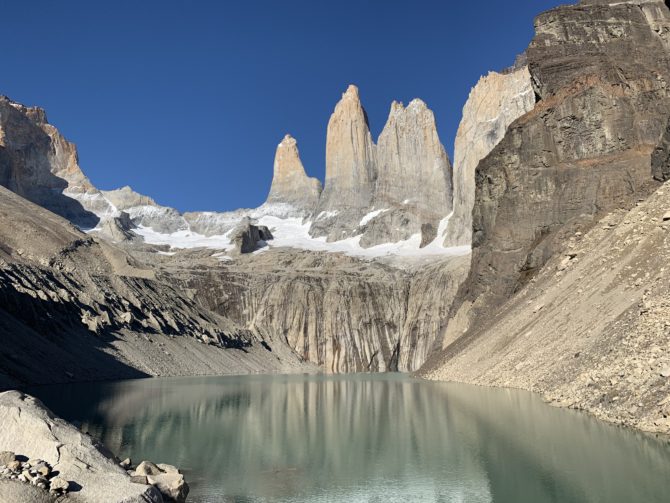
We did feel a bit pushed for time on the last day because we wanted to catch the 2pm shuttle bus out of the park rather than waiting for the later one at 7pm. So we set off back down from las Torres at a determined pace, stopping quickly for lunch and final repacking at Chileno before continuing all the way down to the hotel and welcome centre at the eastern entrance to the park. Thankfully it became clear that we were decently ahead of schedule and although my knee was hurting from the steep descent I was mostly just feeling very, very glad that we had never had to walk this path in the other direction. Sure, we must have covered the same altitude on the previous day, but our route had never felt like a nasty uphill slog.
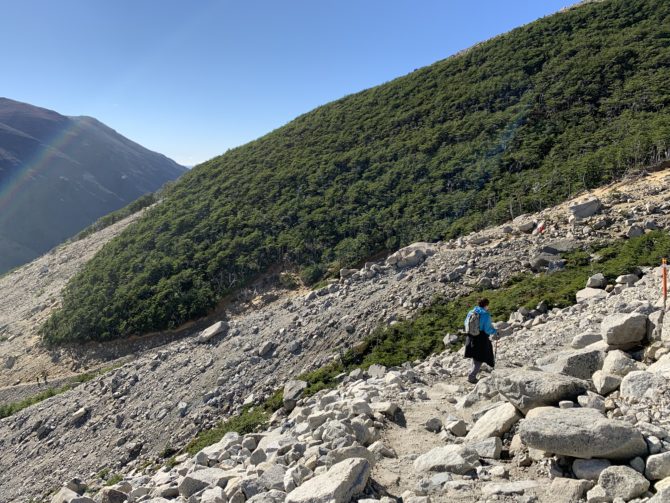
Since we had been going downhill we weren’t even particularly wiped out by the time we reached the welcome centre, paid for the shuttle bus and rode back into Puerto Natales. But we did feel a sense of accomplishment – we’d completed the W trek, and enjoyed it! We got back into town with enough time to return all of our rented equipment, check back into the Airbnb where we had left the rest of our stuff and then celebrate with drinks, pizza and dessert pizza. Also, we could throw out stuff into bins again! When you have to carry everything on your back it is really annoying not to be able to throw away rubbish. Yes yes, I understand why. I’m just saying that bins are an under-appreciated part of civilisation.


Final Thoughts
Although the W Trek was my first multi-day unguided trek I had felt pretty ready for it given that I’d already done most of the constituent parts over the years (hiking, camping, getting used to sleeping bags) and had even accumulated most of the equipment to do it comfortably. In fact, special shout-outs are due to Tash for a microfibre towel, Jesús for the waterproof bag and Randi’s mum Beth for my hiking shoes – all of these gifts over the years really came together on this trek!
There’s very little that I would change if I were doing it again. The biggest thing I’ve learnt is probably to buckle and tighten all of the straps on my backpack, even the fiddly little side ones which seem superfluous. And also that earlier start times really do make a big difference. I was a little bit worried about my back because it had started hurting in the week leading up to the trek, but was pleasantly surprised to discover that so many different body parts started to hurt over the course of the W – one day my shoulders, the next an ankle – that by the end I had completely forgotten about my back and could enjoy a real anthology collection of aches.

For anyone still reading (and I expect even Randi’s parents – who apparently take turns reading our blogs out loud – have given up by now) I have two more important notes about the W. The first is that some of the signage is just flat-out wrong. It’s really odd, because the whole thing is generally very well-organised, the trails are very popular and busy and you’re given a decent map to use on the way in. But then some of the engraved wooden signs state utterly wrong distances or have landmarks in the wrong place, to the extent that someone has made corrections with a ballpoint pen. Dear CONAF: maybe you should fix this?
The second thing is that when walking for this many hours you are bound to get a jingle stuck in your head, so choose wisely. Mine was la vida es más fácil from Chile’s Unimarc supermarket, which can be heard here in a cheesy 80s ad but is still played at regular intervals in-store and is really quite delightful. If Jewel in Chicago played a theme tune which was even half as good as this I would never have complained about them.

Tomorrow we get back on a bus to Argentina and thinking about this made me realise that Chile – even accounting for the interruption to visit El Calafate in Argentina last week – is probably now third after the UK and the US in my list of countries by longest consecutive stay. (Non-consecutively I think France is probably third, but I’d have to check some things with my mum on that one.) So farewell, Chile! It’s been a lot of fun.





